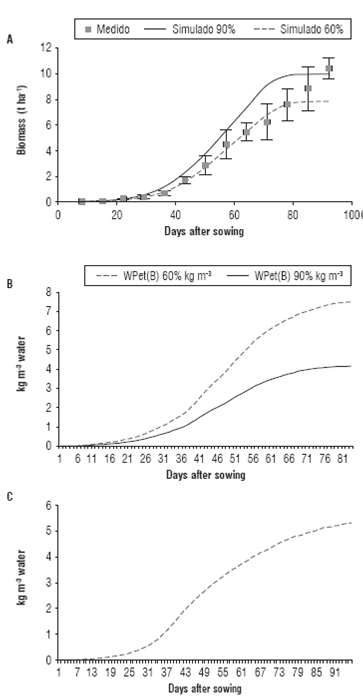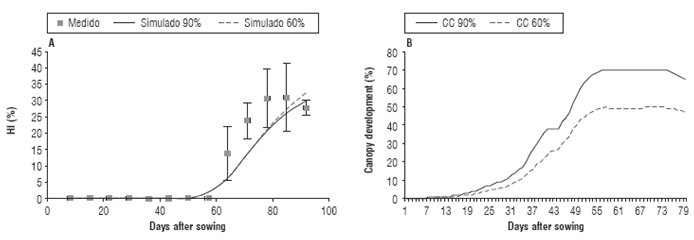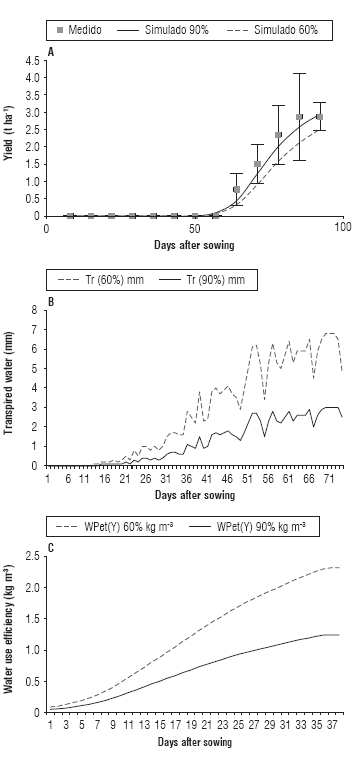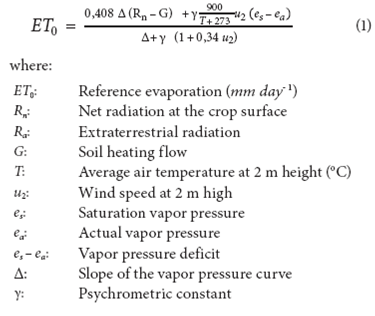Introduction
Maize (Zea mays L.) is a plant native to America (Fenalce, 2013). It is used for human and animal consumption as grain and forage and in industrial use in the form of pre-cooked flours, oils, starches, and as an energy component in the production of balanced animal feed and recently as biofuel (Paliwal, 2001). Worldwide, maize consumption has been increased over time from 80.000.000 t in 2001 to 110.000.000 t by the year 2011; projections show that by 2020 it could reach 180.000.000 t (OECD/FAO, 2011; USDA, 2012). The 'ICA V-156' is a corn variety developed by the Colombian Agricultural Institute (ICA), corresponding to medium-sized plants of good yield potential, resistant to lodging. The 'ICA V-156' provides white grains (Fenalce, 2013; 2012) (in Colombia two types of corn are grown, yellow and white grain). The studies carried out in the context of global climate change (Breton, 2012.; Biazin and Stroosnijder, 2012; Vico and Porporato, 2011; Geerts et al., 2010; Geerts and Raes, 2009), indicated that within areas of greater vulnerability transitory crops (Baldocchi et al., 2002, 2001) such as corn are planted. For adequate develop-ment and production of corn, 961 mm annually of water are required naturally or artificially (Negrete et al., 2004).
Since water is a limiting factor for obtaining high yields in most crops worldwide (Martins et al., 2013), FAO developed the AquaCrop model (Raes et al., 2011.; 2010), which estimates the growth and yield of crops, using the following main sources of information: water flow (Salemi et al., 2011; Steduto et al., 2007), atmospheric conditions, levels of fertilization, soil fertility and plant variety, among others (Steduto et al., 2005).
From the multiple relationships of the factors that govern the functioning of natural ecosystems and crops, knowledge of the eco-physiological mechanisms are fundamental to understand the models, as these provide mechanistic explanations Parameters associated with the weather offer and link with remote sensors satellite (Chuvieco, 2002; Ceccato et al., 2001; Gates, 1965; Goetz et al., 1999) and forecast models with the cycles of energy, carbon and water, which allow one to assess considerable scales of the behavior of ecosystems and agro-ecosystems (Sun et al., 2009; Fageria, 2005; Riano et al., 2005; Bowman, 1989).
Most models take into account the interception of light through the canopy (Geerts, 2010; Geerts et al., 2010.; Reiko et al., 2010; García et al., 2008), leaf area or leaf area index (LAI) for calculations of development and crop yield (Jones et al., 2003). In the same way, with this information energy balances can be calculated to meet the Penman relations (Penman, 1948). The Penman model operates with 33 types of data related to climate, soil, agricultural techniques and crop characteristics that can be easily handled based on data from research and field information from producers (García, 2014). In AquaCrop, the concentration of carbon dioxide is taken from agronomic research stations and ETo is calculated from climate data (Raes et al., 2011; Steduto et al., 2009). Such techniques of modeling and simulation of crop growth have been used in other countries, with excellent results (Cantor et al., 1995).
In AquaCrop, the coefficient of stress simulates the effect of soil fertility in plant growth and maximum canopy development (Raes et al., 2011; Steduto et al., 2007). Also, the soil fertility coefficient is differentiated by the leaf expansion coefficient, when minimized in the canopy. The model takes into account crop management and fertilization levels employed (Sezen et al., 2011). Nutrient uptake is reduced by the lack of water, and a soil fertility voltage and water productivity coefficient (Ks*WP), ranging between 1 and 0, corrects this situation. Therefore, if soil fertility does not affect the process, Ks*WP is equal to 1 and does not affect WP. The yield (Y) is obtained by multiplying the biomass (B) by the adjusted value of the reference harvest index (HIO) (FAO, 2006).
Fertilization levels of maize crops are diverse, for example, in Costa Rica, Fallas et al. (2011) believe that maize hybrid HC-57 with a yield of7,075 t ha-1 requires 111 kg of nitrogen, 43 kg of P2O5, and 168 kg of K2O. Taboada and Alvarez (2008) suggested that in Argentina, 20 to 25 kg ha-1 uptake of N per ton of grain are produced, and similar amounts for P and K; Melgar et al. (2001) suggested the application of minors nutrients in addition to the major elements.
Several studies exist where Eto has been calculated by various methods (García and Fereres, 2012; Liu et al., 2012.; Raez et al, 2011; Lopez Mata et al., 2010.; Trezza, 2008) but the Penman-Monteith (Penman, 1949) study proposed by FAO provides the best answer to calculate potential evapotranspiration, to determine irrigation needs in diverse crops and, therefore, serve better use of fertilizers for crop nutrition.
The aim of this research was to evaluate, the influence of fertilization level on the production of biomass, yield, and its effects on physiological variables and water consumption of corn 'ICA V-156' at the different stages of growth using the AquaCrop model under conditions in a producing zone of Colombia,.
Materials and methods
The plant material used for this research was the corn 'ICA V-156', sown at the rate of 44,444 plants/ha in Cerete (Cordoba, Colombia). From this crop material, biometric measurements and production were evaluated. In addition, the calculation of potential evapotranspiration (ETo) on the site was made, and the AquaCrop model defined, based on the Penman-Monteith method as standard reference. For this purpose, planting took place in the second half of the year, and the data of soil radiation, air temperature, air humidity, georeference and wind speed were taken from the weather station at Corpoica (Turipana) and were based on the formula:
The experimental crop information was based on biometric weekly measurements, biomass and grain harvest, and the model took into account the level of fertilization and nutrient cycling. The categories of levels of soil fertility, ranked by the system were defined, considering that these varied from no limitation (non-limiting) to severe limitation (severely limiting) (Raes et al., 2011). These levels were calibrated from the information obtained on the experimental corn crop plots, to compare the production of potential biomass (result of a proper fertilization), and biomass production in the same type of soil with some limiting fertilization. The relationship was evaluated according to the following expression
At the field level, corn fertilization was performed according to soil analysis, and based on simple sources (Urea, DAP and KCl and a complex of minor elements). For calibration, climate databases were adjusted, and defined the time to reach each stage of crop development, and the morphology and physiology of the plant depending on the location. The basic information obtained by this modeling was development of the canopy, biomass, harvest index, water use and grain yield. With field information, modeling AquaCrop was calibrated and validated in the area studied. After validation, the system (AquaCrop FAO) was run under the fertilization levels of 60 and 90% of the recommended level of fertilization.
Results and discussion
The calculated potential evapotranspiration (ETo) showed extreme values of 0.9 and 7.3 mm (for both fertilization levels assessed). This information was used to calculate the water use, as the model separates the evapotranspiration in transpiration and evaporation, avoiding confusion in the consumptive use of water (Raes et al., 2010); this is especially important in the early stages of crop development (FAO, 2006), because water evaporation on the soil is increases when there is a lack of coverage (Odhiambo and Irmak, 2012). The average calculated ETo was 4.1 mm day-1, a value that permits one to understand the water use in the production of biomass and yield of maize (Li et al., 2011).
Biomass
In order to simulate a 60% decrease in the fertilization level of crop, the biomass produced from the time of seedling emergence to physiological maturity was diminished, presenting a biomass of 9.889 t ha-1 for the 90% level and 7,775 t ha-1 for the 60%; meanwhile the measured biomass was 10,370 t ha-1 (Fig. 1A). This reduction could be due to the reduction of the canopy area (García et al., 2014) from 90 to 70% of the coverage (canopy) of plants. Under the stress fertilization, the amount of biomass produced per unit of water, was an average of 1.63 kg m-3 during the crop cycle (Fig. 1B). When total fertilization was used, there were on average 2.13 kg m-3 of water consumption (Fig. 1 C), although Fernandez et al. (1996) reported that some fertilizers did not influence maize yield when different irrigation frequencies had been used. In the same way, Garcia and Fereres (2012), working with corn and AquaCrop in southwestern Spain, found that the biomass produced by corn ranged between 25.07 and 30.94 t ha-1 for the observed values, and from 28 to 30 t ha-1 for the simulated values. These were values, which differ from those studied and show that there is a potential of biomass production which, possibly, can be translated into a higher potential yield (Wang et al., 2008).

FIGURE 1 A. Production of biomass; B. Water use calculated in kg biomass/m3 of water under two levels of fertilization; C. compared with the use of corn ICA V-156 in normal conditions (AquaCrop-FAO).
The biomass values obtained at 90% fertilization, show a linear regression, supported by a R 2 of 93.91% and the equation y = 0,1475x - 2.8165. Similarly, with the level of 60% fertilization, a linear regression (given by the equation y = 0,1145x - 2.2868) was observed with a R2 of 93.68%.
The harvest indices measured and modeled at 60 and 90% of fertilization were similar (Fig. 2A). The measured value of the harvest index was 27.6%, but when the simulated fertilization was 90 and 60%, harvest index was 32.3 and 29.8%, respectively. Possibly, the leaves had a larger area (each one) and, probably, a higher weight per unit, due to the increased effort of the plant, since the weight of the biomass is represented in large part by the leaves, according to Fageria et al. (2005), in order to capture the photosynthetically active radiation (RAF) (Bowman, 1989).

FIGURE 2 A. Harvest index (HI) and B. Canopy development of corn ICA V-156 under two levels of crop fertilization.
Measuring the amount of water used to form 1 kg of biomass (Fig. 2A) shows that by decreasing the fertilization of corn, this amount of water increased. This may be due to the decreased crop canopy (Fig. 2B). The average amount of water to form biomass was 1.84 and 1.38 m-3 kg-1 for the fertilization levels of 90 and 60%, respectively. Gambín et al. (2006) report that the amount of water available in the soil at the time of flowering and the beginning of grain filling was enough to completely form the cob and grains during their development (Garcia et al., 2014). Also, the maximum evapotranspiration, could have been due to the scarce coverage crop during the early stages of development (Ma et al., 2012) and AquaCrop allowed to differentiate both of these situations (Steduto et al., 2009).
Yield
Comparing the simulated with the observed yield at a fertilization level of 60% (Fig. 3A), it was found that at the end of the modeled and measured period, the values were different with 2.51 t ha-1 for the of 60% fertilization and 2.95 t ha-1 for the 90% level, while the experimental yield was 2.93 t ha-1, suggesting a response to fertilizer application. Not only the level of fertilization that is handled by simulating the crop behavior was affected (Singh and Singh, 1995), but also the water consumption, because at lower levels of fertilization, the water use efficiency is reflected shown by the osmotic potential. Likewise, at 60% crop fertilization, there was an increased water consumption (Fig. 3B), represented by 1.43 mm in average per crop cycle as water transpired; while when 90% fertilization was used, the water transpired per corn plant was 1.1056 mm, on average (Fig. 3B).

FIGURE 3 A. Grain yield obtained with corn ICA V-156, modeling at 60 and 90% level of fertilization at a density of 44,444 plants/ha. B. Amount of water transpired and C. Water used to form yield.
In the application of the AquaCrop model, the calibration of crop physiology (Hsiao et al., 2009), soil profile and amounts of fertilizers are important items for the representation of benchmark yields (Ruane et al., 2013). After 70 d, transpiration decreases (Abedinpour et al., 2012) at both levels of fertilization, coinciding with the beginning of flowering and formation of maize yield for the evaluated site (Fig. 3A and B).
The yield formation was affected according to the level of fertilization (Fig. 3C), since 18.87 kg of grain per cubic meter of water were formed, with a daily average of 0.5241 kg m-3 after flowering at a 60% fertilization level. Likewise, when fertilization was 90%, 23.02 kg m-3 of water were formed Stroosnijder (2012) modeled the application of fertilization at different levels and sources, both organic and chemical, in corn, with AquaCrop and found decreased performance in proportion to the reduction of fertilization.
Conclusions
The use of AquaCrop showed that a fertilization plan at lower doses is recommended. By a decreasing fertilization by10%, the biomass production and maize yield decreased, however, the harvest index was maintained, due to the fact that the yield did not drastically decrease.
Biomass and canopy development were more affected than the rest of the variables by decreasing fertilization. In the same way, 40% less fertilization restricted performance and biomass production, 15.08 and 25.02%, respectively. As fertilization was reduced, water requirements for biomass formation, canopy formation, as well as crop transpiration increased.
A higher fertilization level (90%) achieves a higher amount of grain per m of water used, and 18,027% is the best consumption of water.
















